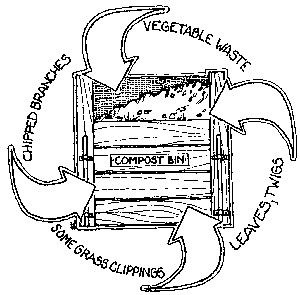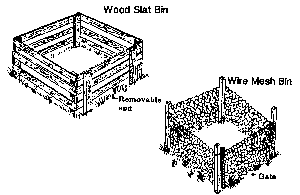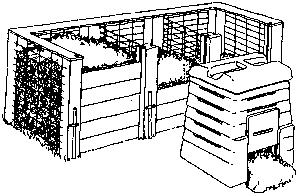by C.R. Wilson and J.R. Feucht* (8/20)
Revised by E. Hammond**
Quick Facts…
- Composting yard waste recycles nutrients back into the yard and saves landfill space.
- Composting reduces yard waste volume by 50 to 75 percent.
- Compost made with manure is questionable for use in food gardens due to newer strains of bacteria that cause food-borne illnesses.
- The microorganisms that break down plant wastes require favorable temperatures, moisture and oxygen.
- Compost can be used as a soil amendment and a mulch.
All yards produce waste from pruning, lawn mowing and other routine plant care activities. Composting is a way to reduce the volume of organic wastes and return them to the soil to benefit growing plants.
Organic matter improves the drainage and aeration of clay soil. Compost can be thought of as a separator that “shoulders apart” tightly packed clay particles to allow water and air to enter. Composting helps sandy soil hold water and nutrients. Compost holds moisture “like a sponge” and releases fertilizer nutrients slowly. It also increases the activity of earthworms and other natural soil organisms that are beneficial to plant growth. Note: Compost is a soil amendment, not a fertilizer. It contains limited plant nutrients.
Making Compost
To make traditional compost, alternate different types of shredded plant materials in 6- to 8-inch layers. Layering helps compost reach the correct nitrogen balance. Use equal parts by volume of dry and green plant materials in the overall mix. Use caution when you add layers of fine green plant wastes such as grass clippings. Grass mats easily and prevents water from moving through the mass during the composting process. Use 2-inch layers of fine materials or process them through a machine shredder. Alternate fine materials with woody plant prunings to prevent clogging the machine and to create an equal balance of dry and green materials.
Traditional composting includes soil as one of the layers. While soil can serve as a source of microbes to “inoculate” plant wastes, research has found that the microorganisms that break down plants also are present on the surface of the leaves and stems. It’s natural for some soil to cling to pulled weeds and uprooted vegetable and flower plants. When you add large amounts of soil, you increase the weight, which makes composting difficult and less efficient. Large amounts of soil also can suffocate microorganisms. Soilless composting is often practiced.
Add water to the compost after every few layers of material. If the plant materials are dry and no green material is available, add a small quantity of blood meal or a commercial nitrogen fertilizer free of weed killers. One-half cup of ammonium sulfate per bushel of material is sufficient. Livestock manure also can be added and supplies some nitrogen. Like soil, manure adds weight and bulk. The space devoted to manure could be used to compost yard wastes.
There is no advantage in adding compost starters or inoculum to the compost. The microbes that cause decomposition multiply just as rapidly from those that are naturally found on the plant waste.

Figure 1: Many materials can be composted. |
Materials to Use and Avoid
A variety of materials can be composted, but most gardeners want to recycle collected yard waste. Plants lose between 50 and 75 percent of their volume in composting, so a lot of plant material can be processed effectively.
Composting can be effective on most yard wastes such as leaves, vegetable and flower plant parts, straw, and a limited amount of woody prunings, grass clippings and weeds. Woody twigs and branches that are greater than 1/4 inch in diameter should first be put through a shredder-chipper. Avoid highly resinous wood and leaf prunings from plants such as junipers, pine, spruce and arborvitae. The resins protect these materials from decomposition and extend the time needed for composting in comparison with other plant materials. High tannin-containing leaves (oak and cottonwood) have similar problems but can be used in small quantities if chopped well and mixed with other materials. The easiest way to handle grass clippings is to leave them on the lawn. Research shows that they return valuable nutrients back to the soil. Some grass clippings can be used for compost if other green plant material isn’t available.
Many, but not all, plant disease organisms are killed if the compost reaches 122 degrees F. Temperatures will vary throughout the compost. Outer layers stay cooler than the center and cause uneven kill of disease organisms. If a plant is severely diseased, it is better to dispose of it in the trash.
| Catching and bagging grass clippings is not worth the effort when they are easily recycled right on the lawn. For details, see fact sheet 7.007, Eliminate Grass Clipping Collection. If clippings are too long to leave on a lawn, composting is a better alternative than disposal in the trash. Some weeds can be composted, particularly if they are pulled before they produce seed. |
In general, avoid plants treated with weed killers. Small amounts of herbicide-treated plants may be mixed in the pile as long as you allow for thorough decomposition. Weed killers and other pesticides break down at various rates. If you use treated grass clippings, the breakdown of these chemicals should be at least as fast as breakdown in the soil. Plants killed with weed killers that are soil inactive (glyphosate products such as Roundup or Kleenup) should present no problem when composted in small quantities.
In addition to yard wastes, many people compost kitchen wastes, such as vegetable scraps, coffee grounds and eggshells. These materials compost well and usually are not produced in large enough quantities to displace yard wastes. Animal wastes (meat, bones, grease, whole eggs and dairy products) may cause odors and attract rodents; they are not recommended. Human, cat or dog feces may transmit diseases and should not be used. Some animal products that can be used as organic sources of nitrogen include blood and steamed bone meal and livestock manures from plant-eating animals (cows, sheep, rabbits and chickens).
Manures may contain new strains of E. coli and other bacteria that cause human illness. The use of manures added directly to the food garden is questionable, although use on ornamental plantings is still recommended. Research shows that 2 to 10 percent of bacterial pathogens survive the composting process. If manure is composted for food gardens, a two- to four-month curing process following composting is necessary to reduce pathogens. Favorable moisture and temperature conditions during curing allow microorganisms to develop and outcompete the pathogens. Thoroughly wash all fruits and vegetables and peel according to safe food handling practices to minimize the possibility of bacteria-contaminated soil being carried into food prepared for human consumption.
Black and white newsprint is best recycled through recycling collection operations rather than converted to compost. If paper is composted due to a shortage of dry materials, add no more than 10 percent of the total weight of the material being composted. Do not use wood ashes or lime for composting in Colorado. Both increase salt and alkalinity, which leads to a loss of nitrogen in the form of ammonia gas.

Figure 2: Wood slat and wire mesh composting bins. |

Figure 3: Three-bin and plastic composters. |
Location and Structures
Choose a composting site carefully. Partial shade avoids baking and drying in summer but provides some solar heat to start the composting action. A site protected from drying winds prevents too much moisture loss. Another consideration is convenience for moving volumes of plant materials in and out of the area. Choose a site close to where material will be used, but not highly visible or that interferes with yard activities.
Structures aren’t necessary for composting, but do prevent wind and marauding animals from carrying away plant wastes. Open compost piles can be used in less-populated rural locales, but structures are a near-must in urban areas. Many composting structures can be purchased or built (Figure 2). They vary in how well they can be managed to meet the requirements for effective decomposition under Colorado environmental conditions. Many people cover their compost with plastic to prevent the outer layers from drying too much. Remove the covers periodically to add more water and plant material and to aerate the mass.
A minimum volume of material is necessary to build up the heat necessary for efficient composting. This volume is generally around 36 inches by 36 inches by 36 inches. Well-insulated wood or plastic structures can be smaller and still hold enough heat to compost well. Wastes should heat up within two days if the compost is put together correctly.
Structures built of wire also may have drying problems. This depends on how many sides are exposed and whether exposure is on the windward side. Plastic covers or tarps often must be used with wire bins. Wood structures do not dry as much, but are generally more expensive to purchase or build. An efficient wood structure is the three-chambered bin system that allows plant material to be aerated by turning it from one bin to the next as it decomposes (Figure 3).
| Compost mainly serves to reduce the volume of yard wastes and convert plant materials into a usable soil amendment. Adding excessive amounts of other materials, such as animal manures, defeats the purpose.In-ground pit composting presents problems with turning or aerating the plant material and also can pool water, which leads to undesirable low oxygen conditions. |
Compact plastic composters are available through garden centers and catalogs (Figure 3). They work well for small yards that produce few plant wastes. Some of these use a vertical composting system where fresh materials are added to the top and finished compost is removed from a drawer in the bottom. This system requires an aeration tool to reach in and stir plant materials on a regular basis. If you use metal barrels for composting, drill holes to allow air to enter. Turn the barrel on its side and roll it to mix and aerate the compost.
Requirements for Effective Composting
The breakdown of organic yard wastes is a biological process dependent on microorganism activity. Like most living things, these microbes require favorable temperatures, moisture, oxygen and nutrients. (See Table 1.)
Temperature. Plant-digesting microbes operate in a temperature range of 70 to 140 degrees, but breakdown occurs slowly at the lower temperatures. Well-managed compost rapidly breaks down in summer when compost temperatures quickly reach 120 to 130 degrees. If summer heat plus the heat produced by active microorganisms causes the temperature of the plant mass to exceed 160 degrees, the microbes will die. Colorado winter temperatures cool compost and greatly extend the time required to produce a finished product.
Maintenance
|
Moisture and oxygen. Moisture and oxygen are essential to microbial activity. In a region of limited rainfall such as Colorado, add moisture regularly to maintain composting. If parts of the composting material dry out, many microorganisms in the dry areas die. Even when moisture is added, the microbes that remain require time to multiply and resume plant digestion. The net result is slower composting. However, excess moisture displaces air and slows breakdown. Surplus water creates low oxygen conditions where certain microbes multiply and produce foul odors. The best description of the proper moisture level is moist or damp but not soggy. The entire mass of plant wastes should be moistened uniformly to the point where only a few drops of water can be squeezed from a fistful of plant material.
The size of plant particles that go into the compost also affects aeration. Large particles allow a lot of air to circulate around the plant chunks, but breakdown is slow because microbes can act only on the outside, not on the inside of the large chunks. Particles chopped into smaller chunks increase the surface area for microbes to operate. Particles chopped too small will compact and restrict air flow. Moderate-sized plant pieces of 1/2 to 1 1/2 inches are the best size to use and can be produced by hand or machine shredding. Chop woody materials into a smaller size. Leave soft plant parts in larger pieces for effective composting. Fluff or turn the material with a pitchfork or aerator tool at regular intervals to provide additional aeration and distribute microbes throughout the compost.
Nutrients. The microbes that break down plants use the plants for food. Nitrogen is the most important food nutrient, because a nitrogen shortage drastically slows the composting process. Woody and dried plant materials tend to contain little nitrogen in comparison to the total mass of the material. Green plant material, however, contains a high percentage of nitrogen. A mix of equal parts by volume of green and dry plant material generally gives the best nitrogen balance. Add a plant fertilizer high in nitrogen when green materials are scarce.
Compost as Soil Amendment and Mulch
Mix soil amendments well with the soil to separate clay particles or hold water in sand. For this reason, prepare soil before planting lawns or trees. Areas planted every year, such as vegetable or annual flower gardens, can accept frequent applications of compost. Indoor potted plants and outdoor container plants benefit from compost as an ingredient in potting soils. As with peat-based mixes, potting soils that use compost require a material such as perlite to avoid waterlogging. Some weed seeds can survive composting, but weed plants can be easily pulled.
Mulches suppress garden weeds, cool soil, conserve moisture and reduce soil erosion. To mulch, apply a 4- to 5-inch layer of organic material on top of the soil instead of mixing it into the soil as with amendments.
Compost can be used as a mulch. It has the disadvantage of being light and easily blown away in the wind, unlike bark or rock mulch that stays in place. Like any organic mulch, compost supports weed growth, which can cause problems if weed seeds blow into the area. While mulches eventually become incorporated into the soil, amending the soil directly with compost is a better solution where soil conditions limit plant growth.
| Table 1: A troubleshooting guide for effective composting. | ||
| Symptom | Cause | Solution |
|---|---|---|
| Compost has a bad odor. | Lack of air. | Turn or use a tool to aerate it. |
| The center of the mass is dry. | Lack of water, not watering regularly. | Moisten materials while stirring or turning the pile. |
| The outside couple of inches are dry. | Dry Colorado air. | Water regularly or cover with a plastic sheet or tarp. |
| The center is damp and warm. | Too small a plant mass overall. | Collect more plant materials; mix with the old to form a new mass. |
| Outside is cool and slightly dry. Plant wastes are damp and sweet smelling but mass will not heat up. | Lack of nitrogen. | Mix in a nitrogen source: fresh grass, granular fertilizer, bloodmeal or manure. |
*C.R. Wilson, former Colorado State University Extension horticulture agent, Denver County; and J.R. Feucht, Extension landscape plant specialist and professor (retired), horticulture. *E. Hammond, Colorado State University Extension agent, horticulture, Adams County. 10/97. Revised 8/20.
Go to top of this page.





